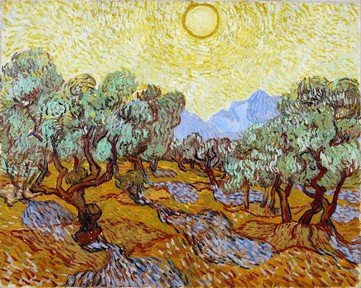Quiz Answer Key and Fun Facts
1. In designing a quiz on paintings showing food and drink, one might be tempted to ask for the title of Leonardo da Vinci's masterpiece painted on the walls of the Santa Maria delle Grazie convent near Milan. However, I thought this would be too easy. Hence the following question. What type of bread should be painted in da Vinci's "The Last Supper"?
2. In which merry painting by Pieter Brueghel the Elder can you find a group serving what seem to be rice cakes?
3. At the National Gallery in London, you'll find four paintings by the same minor Belgian artist. These paintings are entitled "Water" (with a large quantity of fish), "Air" (abundant with fowl and eggs), "Earth" (plenty of vegetables and fruits) and "Fire" (in which we can find a lot of red meat to be roasted or dried over fire). Who painted this series, completed in 1570?
4. In 1593, Caravaggio painted "Sick Bacchus". Bacchus holds some kind of fruit in his right hand, as if he's ready to taste it. What is this fruit? Please pay attention: we ask for the fruit Bacchus holds *in his hand* in the painting of 1593, and not for the fruits on the table in this painting or the painting of 1596.
5. The earliest prominent work of Peter Paul Rubens, made before he left for Italy in May 1600, is entitled "The Fall of Man". The corresponding Bible passage (Genesis 3:1-7) describes Adam and Eve eating the fruit of the Tree of Knowledge of Good and Evil. Does Rubens' painting show the fruit of this Tree?
6. One of the rare still-lives painted by Goya represents a plucked bird, just beside a pan with (seemingly) some mussels. You might think these ingredients would come together in the Spanish dish paella, but the classical recipe includes chicken and not the depicted bird. This bird (stemming from the Americas) has given its name to the painting. Fill in the missing word: "Plucked _____"
7. "Still Life with a Plate of Cherries", "Still Life with Apples and Oranges" and "Apples, Peaches, Pears and Grapes" are a few titles of paintings by a French artist. Which French Post-Impressionist left us several fruity still-lives?
8. "The Potato Eaters" (1885) was one of the first masterpieces of a Dutch Impressionist painter. Who left us this impression of utter poverty, where a family of five apparently shares one single potato?
9. When reading a list of paintings by this Spanish master, I was puzzled by the title "Eggs on a Plate without the Plate". So I've searched the net to find out what this picture represents. It shows us three eggs fried "sunny side up". One of these eggs is lifted in the air with a little string tied into the egg white. Which Spanish painter produced this Surrealist tableau?
10. Andy Warhol could not miss out on an appointment with a quiz on food in paintings. He made in 1962 a series of lithographs showing us cans of Campbell's soup. Did he depict any other soup cans than Campbell's tomato soup?
Source: Author
JanIQ
This quiz was reviewed by FunTrivia editor
CellarDoor before going online.
Any errors found in FunTrivia content are routinely corrected through our feedback system.
